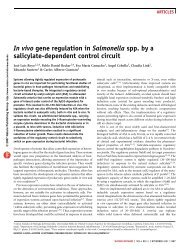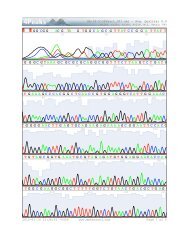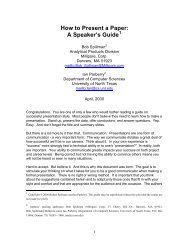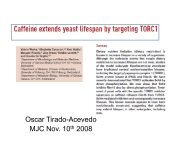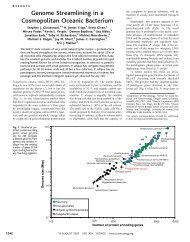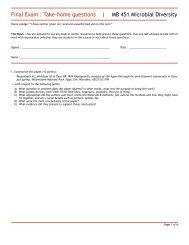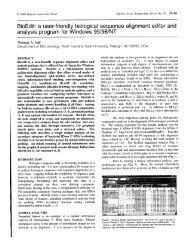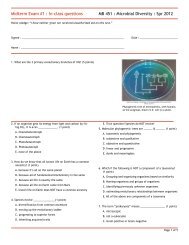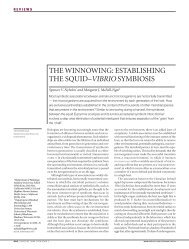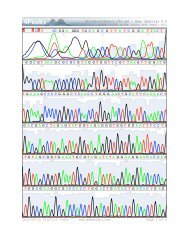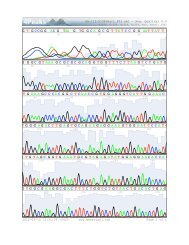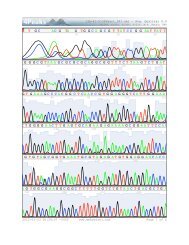Schedule and Program - North Carolina Academy of Science
Schedule and Program - North Carolina Academy of Science
Schedule and Program - North Carolina Academy of Science
Create successful ePaper yourself
Turn your PDF publications into a flip-book with our unique Google optimized e-Paper software.
factors represent an intriguing target for combined cancer therapy. Due to their ability to differentiate in culture,colon cancer cell lines represent a useful model for investigating the role <strong>of</strong> Hox genes in oncogenesis. Currently,our laboratory has characterized the expression pattern for all <strong>of</strong> the 39 Hox genes. It has been shown that Hoxgenes B8, C8 <strong>and</strong> C9 are up-regulated in colorectal cancers. Hox gene expression will further be investigatedin a human colorectal adenocarcinoma cell line (HT29) by focusing on paralog groups 8 <strong>and</strong> 9. My hypothesisis that differentiated cells will have an increased level <strong>of</strong> expression <strong>of</strong> paralog groups 8 <strong>and</strong> 9 in comparison toundifferentiated cells. Expression levels will be analyzed using qRT-PCR <strong>and</strong> st<strong>and</strong>ardized to a housekeeping gene,RPLP0. Additionally, when silenced using siRNA transfection, cells lacking expression <strong>of</strong> genes in paralogs 8 <strong>and</strong>/or 9 will have a decreased ability to differentiate, produce tight junctions <strong>and</strong> apical brush borders. These resultscould provide initial answers to the underst<strong>and</strong>ing <strong>of</strong> the function <strong>of</strong> Hox genes during colon carcinogenesis <strong>and</strong>provide possible targets for combined cancer therapy.Temperature <strong>and</strong> carbon dioxide effects on carbonic anhydrase in Aiptasia spp.Rachel L. Cone*, Constance Rogers-Lowery, <strong>and</strong> Mark SaboCatawba CollegeCarbonic Anhydrase is a zinc metalloenzyme that catalyses the reaction <strong>of</strong> carbon dioxide to bicarbonate. Bicarbonateis a key element in exoskeleton formation <strong>of</strong> marine animals. Aiptasia spp. (sea anemone) are hardy members <strong>of</strong>the group cnidarians. They depend on carbonic anhydrase to catalyze the reaction <strong>of</strong> CO2 into bicarbonate <strong>and</strong>provide the necessary element for calcification to occur. Sea anemones were treated with CO2 concentrations <strong>of</strong>392ppm, 700ppm <strong>and</strong> 1300ppm. Their homogenized tissue was used for analysis with a colorimetric method on aUV-VIS spectrophotometer. Samples ran at temperatures <strong>of</strong> 10º, 20 º, <strong>and</strong> 30 º C <strong>and</strong> absorbencies were recorded.Carbonic anhydrase activity levels were determined in units <strong>of</strong> activity per gram <strong>of</strong> protein. Protein concentrationswere determined using the Bradford assay. There was a significant increase in activity level according to increase intemperature. There was a significant difference between CO2 treatment groups.Does Microstegium vimineum show contemporary evolution along analtitudinal gradient?Alex<strong>and</strong>ra M. Congelosi Presenter, <strong>and</strong> Elizabeth P. LaceyUNCGCurrently invasive plant species are becoming a major concern because they have been found to decreasebiodiversity <strong>and</strong> inhibit growth <strong>of</strong> native species. Microstegium vimineum, commonly known, as JapaneseStiltgrass is an invasive grass that originates from Japan <strong>and</strong> since its arrival it has spread all throughout thesoutheastern part <strong>of</strong> the United States causing detrimental effects to native plant species. Considering how quicklyM. vimineum has spread to so many variable environments since its arrival, it is possible that this invasive grass hasundergone contemporary evolution. To test for contemporary evolution I will be examining population variationalong an altitudinal gradient. Previous studies <strong>of</strong> plants species (both native <strong>and</strong> invasive) along an altitudinalgradient have shown that as altitude increases, above-ground biomass <strong>and</strong> inflorescence number decrease. I amtesting the hypothesis that M. vimineum shows similar population differences. I also hypothesize that higheraltitude populations will flower earlier <strong>and</strong> have lower above-ground biomass than lower altitude populations <strong>and</strong>that high altitude populations will germinate later in the season <strong>and</strong> have a greater proportion <strong>of</strong> cleistogamousseeds than low altitude populations. I will discuss the experiments that I am conducting to test these hypotheses.Campbell University - 39




